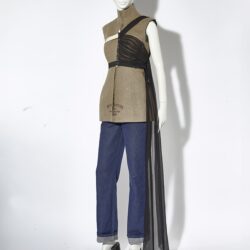A Pattern Cutter at MoMu Library: Symbiosis of Craft and Technology

Following the recent appointment of Stijn Van den Bulck, MoMu Library now also has a pattern cutter in house. While pattern-cutting may not be the first thing that comes to mind when thinking of a library team, for Stijn, it is logic itself. Find out why and what he plans to do with the study collection and the Pattern-a-thons.
I'm constantly looking at the clothes people wear and mentally making patterns of them. That design aspect is what still fascinates me most about my profession. As a pattern cutter, you literally map out garments.
Your role at the MoMu Library consists in digitally mapping out the study collection. How do you intend to tackle that role?
STIJN VAN DEN BULCK: "Like a blank page that I've been given the opportunity to fill. My task is to take the silhouettes from the study collection that are physically hanging here and make them available digitally as well. Currently, you can find information about these pieces online, but you still have to make an appointment to view them in the library. My job is to digitalise the paper patterns so that the library can make them available online. Suppose you live abroad and want to research or recreate the fencing jacket from the collection. You would then not only find the description and a few pictures, but also a pattern and a 3D version as well."
Why is MoMu Library investing in this digital aspect?
SVDB: "Because gathering and disseminating information is one of its core functions. We have also realised that this digital portal actually provides a great many possibilities. Combining craft heritage with new technologies is also super interesting and challenging. As far as I know, not many other fashion museums have an in-house pattern cutter. Funnily enough, I was always wondering if employing a pattern cutter wouldn't be a logical step for that kind of institution, even before I came across the job posting."

Can you tell us more?
SVDB: "Conserving historical garments forms a significant part of their operations. Capturing those pieces in patterns and 3D replicas as well means you can preserve them better. Because once they're gone, they're gone. So if any of those pieces is ever lost, you will at least still have a digital version that you can physically recreate if you want to."

Next to digitalising the study collection, you will also be supervising the Pattern-a-thons. How do you see yourself doing that?
SVDB: "Those workshops – which require no prior knowledge – are fascinating because they approach pattern-cutting from a completely different angle. The patterns that the participants create based on pieces from the study collection are not commercial products or items for daily use. So this opens things up and enables us to digitalise the collection in an original way. I intend to put together a template for the workshops so that other institutions can organise them as well."



